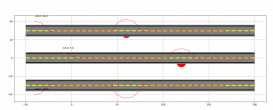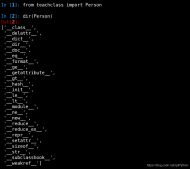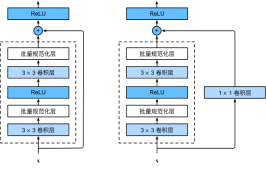RegEx 或正则表达式是形成搜索模式的字符序列。
RegEx 可用于检查字符串是否包含指定的搜索模式。
RegEx 模块
Python 提供名为 re 的内置包,可用于处理正则表达式。
导入 re 模块:
|
1
|
import re |
Python 中的 RegEx
导入 re 模块后,就可以开始使用正则表达式了:
实例
检索字符串以查看它是否以 “China” 开头并以 “country” 结尾:
|
1
2
3
4
|
import retxt = "China is a great country"x = re.search("^China.*country$", txt) |
运行实例
|
1
2
3
4
5
6
7
8
9
|
import retxt = "China is a great country"x = re.search("^China.*country$", txt)if (x): print("YES! We have a match!")else: print("No match") |

RegEx 函数
re 模块提供了一组函数,允许我们检索字符串以进行匹配:

元字符
元字符是具有特殊含义的字符
字符:[] 描述:一组字符 示例:“[a-m]”
|
1
2
3
4
5
6
7
8
|
import restr = "The rain in Spain"#Find all lower case characters alphabetically between "a" and "m":x = re.findall("[a-m]", str)print(x) |
运行示例

字符: 描述:示意特殊序列(也可用于转义特殊字符) 示例:“\d”
|
1
2
3
4
5
6
7
8
|
import restr = "That will be 59 dollars"#Find all digit characters:x = re.findall("\d", str)print(x) |
运行示例

字符:. 描述:任何字符(换行符除外) 示例: “he…o”
|
1
2
3
4
5
6
7
8
|
import restr = "hello world"#Search for a sequence that starts with "he", followed by two (any) characters, and an "o":x = re.findall("he..o", str)print(x) |
运行示例

字符:^ 描述:起始于 示例: “^hello”
|
1
2
3
4
5
6
7
8
9
10
11
|
import restr = "hello world"#Check if the string starts with 'hello':x = re.findall("^hello", str)if (x): print("Yes, the string starts with 'hello'")else: print("No match") |
运行示例

字符:$ 描述:结束于 示例:“world$”
|
1
2
3
4
5
6
7
8
9
10
11
|
import restr = "hello world"#Check if the string ends with 'world':x = re.findall("world$", str)if (x): print("Yes, the string ends with 'world'")else: print("No match") |
运行示例

字符:* 描述:零次或多次出现 示例:“aix*”
|
1
2
3
4
5
6
7
8
9
10
11
12
13
14
|
import restr = "The rain in Spain falls mainly in the plain!"#Check if the string contains "ai" followed by 0 or more "x" characters:x = re.findall("aix*", str)print(x)if (x): print("Yes, there is at least one match!")else: print("No match") |
运行示例

字符:+ 描述:一次或多次出现 示例: “aix+”
|
1
2
3
4
5
6
7
8
9
10
11
12
13
14
|
import restr = "The rain in Spain falls mainly in the plain!"#Check if the string contains "ai" followed by 1 or more "x" characters:x = re.findall("aix+", str)print(x)if (x): print("Yes, there is at least one match!")else: print("No match") |
运行示例

字符:{} 描述: 确切地指定的出现次数 示例:“al{2}”
|
1
2
3
4
5
6
7
8
9
10
11
12
13
14
|
import restr = "The rain in Spain falls mainly in the plain!"#Check if the string contains "a" followed by exactly two "l" characters:x = re.findall("al{2}", str)print(x)if (x): print("Yes, there is at least one match!")else: print("No match") |
运行示例

字符:| 描述:两者任一 示例:“falls|stays”
|
1
2
3
4
5
6
7
8
9
10
11
12
13
14
|
import restr = "The rain in Spain falls mainly in the plain!"#Check if the string contains either "falls" or "stays":x = re.findall("falls|stays", str)print(x)if (x): print("Yes, there is at least one match!")else: print("No match") |
运行示例

字符:() 描述:捕获和分组
特殊序列
特殊序列指的是 \ 后跟下表中的某个字符,拥有特殊含义。
字符:\A 描述:如果指定的字符位于字符串的开头,则返回匹配项 示例:“\AThe”
|
1
2
3
4
5
6
7
8
9
10
11
12
13
14
|
import restr = "The rain in Spain"#Check if the string starts with "The":x = re.findall("\AThe", str)print(x)if (x): print("Yes, there is a match!")else: print("No match") |
运行示例

字符:\b
描述:返回指定字符位于单词的开头或末尾的匹配项
示例:r"\bain"
|
1
2
3
4
5
6
7
8
9
10
11
12
13
14
|
import restr = "The rain in Spain"#Check if "ain" is present at the beginning of a WORD:x = re.findall(r"\bain", str)print(x)if (x): print("Yes, there is at least one match!")else: print("No match") |
运行示例

示例:r"ain\b"
|
1
2
3
4
5
6
7
8
9
10
11
12
13
14
|
import restr = "The rain in Spain"#Check if "ain" is present at the end of a WORD:x = re.findall(r"ain\b", str)print(x)if (x): print("Yes, there is at least one match!")else: print("No match") |
运行示例

字符:\B
描述:返回指定字符存在的匹配项,但不在单词的开头(或结尾处)
示例:r"\Bain"
|
1
2
3
4
5
6
7
8
9
10
11
12
13
14
|
import restr = "The rain in Spain"#Check if "ain" is present, but NOT at the beginning of a word:x = re.findall(r"\Bain", str)print(x)if (x): print("Yes, there is at least one match!")else: print("No match") |
运行示例

示例:r"ain\B"
|
1
2
3
4
5
6
7
8
9
10
11
12
13
14
|
import restr = "The rain in Spain"#Check if "ain" is present, but NOT at the end of a word:x = re.findall(r"ain\B", str)print(x)if (x): print("Yes, there is at least one match!")else: print("No match") |
运行示例

字符:\d
描述:返回字符串包含数字的匹配项(数字 0-9)
示例:“\d”
|
1
2
3
4
5
6
7
8
9
10
11
12
13
14
|
import restr = "The rain in Spain"#Check if the string contains any digits (numbers from 0-9):x = re.findall("\d", str)print(x)if (x): print("Yes, there is at least one match!")else: print("No match") |
运行示例

字符:\D
描述:返回字符串不包含数字的匹配项
示例:“\D”
|
1
2
3
4
5
6
7
8
9
10
11
12
13
14
|
import restr = "The rain in Spain"#Return a match at every no-digit character:x = re.findall("\D", str)print(x)if (x): print("Yes, there is at least one match!")else: print("No match") |
运行示例

字符:\s
描述:返回字符串包含空白字符的匹配项
示例:“\s”
|
1
2
3
4
5
6
7
8
9
10
11
12
13
14
|
import restr = "The rain in Spain"#Return a match at every white-space character:x = re.findall("\s", str)print(x)if (x): print("Yes, there is at least one match!")else: print("No match") |
运行示例

字符:\S
描述:返回字符串不包含空白字符的匹配项
示例:“\S”
|
1
2
3
4
5
6
7
8
9
10
11
12
13
14
|
import restr = "The rain in Spain"#Return a match at every NON white-space character:x = re.findall("\S", str)print(x)if (x): print("Yes, there is at least one match!")else: print("No match") |
运行示例

字符:\w
描述: 返回一个匹配项,其中字符串包含任何单词字符 (从 a 到 Z 的字符,从 0 到 9 的数字和下划线 _ 字符)
示例:“\w”
|
1
2
3
4
5
6
7
8
9
10
11
12
13
14
|
import restr = "The rain in Spain"#Return a match at every word character (characters from a to Z, digits from 0-9, and the underscore _ character):x = re.findall("\w", str)print(x)if (x): print("Yes, there is at least one match!")else: print("No match") |
运行示例

字符:\W
描述:返回一个匹配项,其中字符串不包含任何单词字符
示例:“\W”
|
1
2
3
4
5
6
7
8
9
10
11
12
13
14
|
import restr = "The rain in Spain"#Return a match at every NON word character (characters NOT between a and Z. Like "!", "?" white-space etc.):x = re.findall("\W", str)print(x)if (x): print("Yes, there is at least one match!")else: print("No match") |
运行示例

字符:\Z
描述:如果指定的字符位于字符串的末尾,则返回匹配项 。
示例:“Spain\Z”
|
1
2
3
4
5
6
7
8
9
10
11
12
13
14
|
import restr = "The rain in Spain"#Check if the string ends with "Spain":x = re.findall("Spain\Z", str)print(x)if (x): print("Yes, there is a match!")else: print("No match") |
运行示例

集合(Set)
集合(Set)是一对方括号 [] 内的一组字符,具有特殊含义。
字符:[arn]
描述:返回一个匹配项,其中存在指定字符(a,r 或 n)之一
示例
|
1
2
3
4
5
6
7
8
9
10
11
12
13
14
|
import restr = "The rain in Spain"#Check if the string has any a, r, or n characters:x = re.findall("[arn]", str)print(x)if (x): print("Yes, there is at least one match!")else: print("No match") |
运行示例

字符:[a-n]
描述:返回字母顺序 a 和 n 之间的任意小写字符匹配项
示例
|
1
2
3
4
5
6
7
8
9
10
11
12
13
14
|
import restr = "The rain in Spain"#Check if the string has any characters between a and n:x = re.findall("[a-n]", str)print(x)if (x): print("Yes, there is at least one match!")else: print("No match") |
运行示例

字符:[^arn]
描述:返回除 a、r 和 n 之外的任意字符的匹配项
示例
|
1
2
3
4
5
6
7
8
9
10
11
12
13
14
|
import restr = "The rain in Spain"#Check if the string has other characters than a, r, or n:x = re.findall("[^arn]", str)print(x)if (x): print("Yes, there is at least one match!")else: print("No match") |
运行示例

字符:[0123]
描述:返回存在任何指定数字(0、1、2 或 3)的匹配项
示例
|
1
2
3
4
5
6
7
8
9
10
11
12
13
14
|
import restr = "The rain in Spain"#Check if the string has any 0, 1, 2, or 3 digits:x = re.findall("[0123]", str)print(x)if (x): print("Yes, there is at least one match!")else: print("No match") |
运行示例

字符:[0-9]
描述:返回 0 与 9 之间任意数字的匹配
示例
|
1
2
3
4
5
6
7
8
9
10
11
12
13
14
|
import restr = "8 times before 11:45 AM"#Check if the string has any digits:x = re.findall("[0-9]", str)print(x)if (x): print("Yes, there is at least one match!")else: print("No match") |
运行示例

字符:[0-5][0-9]
描述:返回介于 0 到 9 之间的任何数字的匹配项
示例
|
1
2
3
4
5
6
7
8
9
10
11
12
13
14
|
import restr = "8 times before 11:45 AM"#Check if the string has any two-digit numbers, from 00 to 59:x = re.findall("[0-5][0-9]", str)print(x)if (x): print("Yes, there is at least one match!")else: print("No match") |
运行示例

字符:[a-zA-Z]
描述:返回字母顺序 a 和 z 之间的任何字符的匹配,小写或大写
示例
|
1
2
3
4
5
6
7
8
9
10
11
12
13
14
|
import restr = "8 times before 11:45 AM"#Check if the string has any characters from a to z lower case, and A to Z upper case:x = re.findall("[a-zA-Z]", str)print(x)if (x): print("Yes, there is at least one match!")else: print("No match") |
运行示例

字符:[+]
描述:在集合中,+、*、.、|、()、$、{} 没有特殊含义,因此 [+] 表示:返回字符串中任何 + 字符的匹配项。
示例
|
1
2
3
4
5
6
7
8
9
10
11
12
13
14
|
import restr = "8 times before 11:45 AM"#Check if the string has any + characters:x = re.findall("[+]", str)print(x)if (x): print("Yes, there is at least one match!")else: print("No match") |
运行示例

findall() 函数
findall() 函数返回包含所有匹配项的列表。
实例
打印所有匹配的列表
|
1
2
3
4
5
|
import restr = "China is a great country"x = re.findall("a", str)print(x) |
运行实例

这个列表以被找到的顺序包含匹配项。
如果未找到匹配项,则返回空列表。
实例
如果未找到匹配,则返回空列表:
|
1
2
3
4
5
|
import restr = "China is a great country"x = re.findall("USA", str)print(x) |
运行实例

search() 函数
search() 函数搜索字符串中的匹配项,如果存在匹配则返回 Match 对象。
如果有多个匹配,则仅返回首个匹配项。
实例
在字符串中搜索第一个空白字符
|
1
2
3
4
5
6
|
import restr = "China is a great country"x = re.search("\s", str)print("The first white-space character is located in position:", x.start()) |
运行实例

如果未找到匹配,则返回值 None:
实例
进行不返回匹配的检索
|
1
2
3
4
5
|
import restr = "China is a great country"x = re.search("USA", str)print(x) |
运行实例

split() 函数
split() 函数返回一个列表,其中字符串在每次匹配时被拆分。
实例
在每个空白字符处进行拆分
|
1
2
3
4
5
|
import restr = "China is a great country"x = re.split("\s", str)print(x) |
运行实例

可以通过指定 maxsplit 参数来控制出现次数:
实例
仅在首次出现时拆分字符串:
|
1
2
3
4
5
|
import restr = "China is a great country"x = re.split("\s", str, 1)print(x) |
运行实例

sub() 函数
sub() 函数把匹配替换为您选择的文本
实例
用数字 9 替换每个空白字符
|
1
2
3
4
5
|
import restr = "China is a great country"x = re.sub("\s", "9", str)print(x) |
运行实例

可以通过指定 count 参数来控制替换次数:
实例
替换前两次出现
|
1
2
3
4
5
|
import restr = "China is a great country"x = re.sub("\s", "9", str, 2)print(x) |
运行实例

Match 对象
Match 对象是包含有关搜索和结果信息的对象。
注释:如果没有匹配,则返回值 None,而不是 Match 对象。
实例
执行会返回 Match 对象的搜索:
|
1
2
3
4
5
|
import restr = "China is a great country"x = re.search("a", str)print(x) # 将打印一个对象 |
运行实例

Match 对象提供了用于取回有关搜索及结果信息的属性和方法:
-
span()返回的元组包含了匹配的开始和结束位置 -
.string返回传入函数的字符串 -
group()返回匹配的字符串部分
实例
打印首个匹配出现的位置(开始和结束位置)。
正则表达式查找以大写 “C” 开头的任何单词:
|
1
2
3
4
5
|
import restr = "China is a great country"x = re.search(r"\bC\w+", str)print(x.span()) |
运行实例

实例
打印传入函数的字符串
|
1
2
3
4
5
|
import restr = "China is a great country"x = re.search(r"\bC\w+", str)print(x.string) |
运行实例

实例
打印匹配的字符串部分
正则表达式查找以大写 “C” 开头的任何单词:
|
1
2
3
4
5
|
import restr = "China is a great country"x = re.search(r"\bC\w+", str)print(x.group()) |
运行实例

注释:如果没有匹配项,则返回值 None,而不是 Match 对象。
到此这篇关于Python入门教程(二十九)Python的RegEx的文章就介绍到这了,更多相关Python的RegEx内容请搜索服务器之家以前的文章或继续浏览下面的相关文章希望大家以后多多支持服务器之家!
原文链接:https://blog.csdn.net/ooowwq/article/details/129410936










